The AMD Radeon R9 290 Review
by Ryan Smith on November 5, 2013 12:01 AM EST- Posted in
- GPUs
- AMD
- Radeon
- Hawaii
- Radeon 200
Compute
Jumping into pure compute performance, this is another scenario where the 290X shouldn’t throttle as much, and as such the performance differences between the 290 and 290X should be closer to what they are on paper. With compute workloads the ROPs aren’t being hit hard, so that’s power and thermal savings that lets both cards operate at close to their maximum boost clocks.
As always we'll start with our DirectCompute game example, Civilization V, which uses DirectCompute to decompress textures on the fly. Civ V includes a sub-benchmark that exclusively tests the speed of their texture decompression algorithm by repeatedly decompressing the textures required for one of the game’s leader scenes. While DirectCompute is used in many games, this is one of the only games with a benchmark that can isolate the use of DirectCompute and its resulting performance.
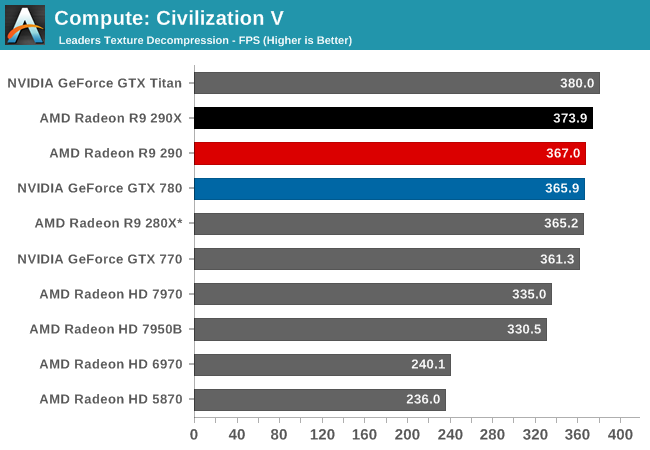
As with the 290X, Civ V can’t tell us much of value due to the fact that we’re running into CPU bottlenecks, not to mention increasingly absurd frame rates. The 290 is marginally slower than the 290X due to the lower clockspeeds and missing CUs, but minimally so.
Our next benchmark is LuxMark2.0, the official benchmark of SmallLuxGPU 2.0. SmallLuxGPU is an OpenCL accelerated ray tracer that is part of the larger LuxRender suite. Ray tracing has become a stronghold for GPUs in recent years as ray tracing maps well to GPU pipelines, allowing artists to render scenes much more quickly than with CPUs alone.
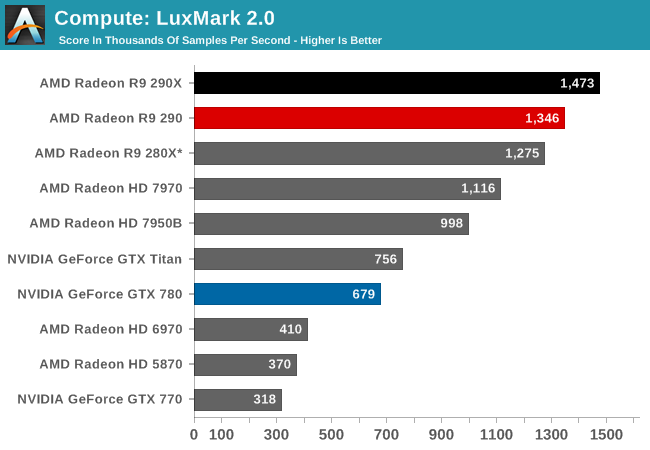
With both cards unthrottled and bound solely by shader performance, it’s an outright foot race for the Radeon cards. 290 trails 290X by around 9%, closely mirroring the difference in the CU count between the two cards. Though 290 is being very closely chased by the 280X, as Hawaii in general seems to have trouble getting the most out of its shader hardware on this benchmark.
Our 3rd compute benchmark is Sony Vegas Pro 12, an OpenGL and OpenCL video editing and authoring package. Vegas can use GPUs in a few different ways, the primary uses being to accelerate the video effects and compositing process itself, and in the video encoding step. With video encoding being increasingly offloaded to dedicated DSPs these days we’re focusing on the editing and compositing process, rendering to a low CPU overhead format (XDCAM EX). This specific test comes from Sony, and measures how long it takes to render a video.
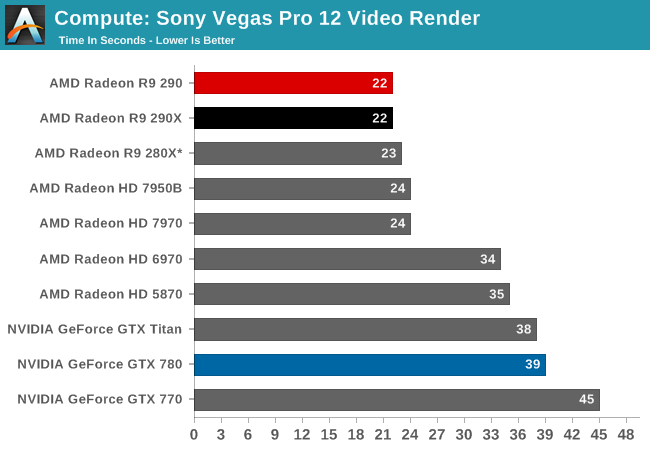
There’s not enough of a GPU performance difference between the two cards to matter with this test. Both tie at 22 seconds.
Our 4th benchmark set comes from CLBenchmark 1.1. CLBenchmark contains a number of subtests; we’re focusing on the most practical of them, the computer vision test and the fluid simulation test. The former being a useful proxy for computer imaging tasks where systems are required to parse images and identify features (e.g. humans), while fluid simulations are common in professional graphics work and games alike.
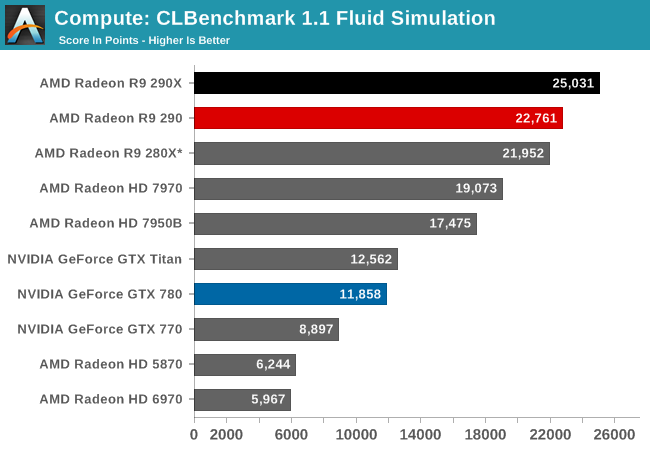

In the CLBenchmark fluid simulation the 290X and 290 take the top spots as expected, with the 290 trailing once more by 9%. However both Hawaii cards are still struggling with the computer vision benchmark, leading to the 290 being edged out by the 7970 of all things.
Moving on, our 5th compute benchmark is FAHBench, the official Folding @ Home benchmark. Folding @ Home is the popular Stanford-backed research and distributed computing initiative that has work distributed to millions of volunteer computers over the internet, each of which is responsible for a tiny slice of a protein folding simulation. FAHBench can test both single precision and double precision floating point performance, with single precision being the most useful metric for most consumer cards due to their low double precision performance. Each precision has two modes, explicit and implicit, the difference being whether water atoms are included in the simulation, which adds quite a bit of work and overhead. This is another OpenCL test, as Folding @ Home has moved exclusively to OpenCL this year with FAHCore 17.
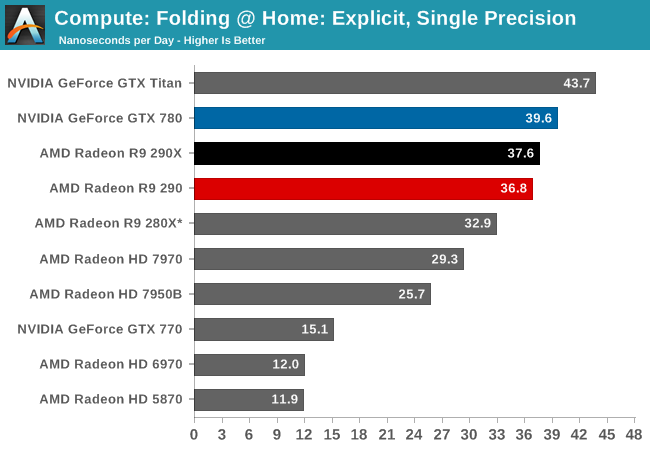
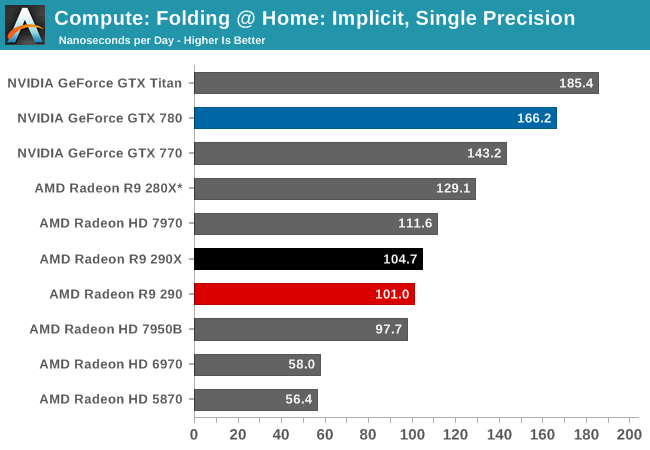
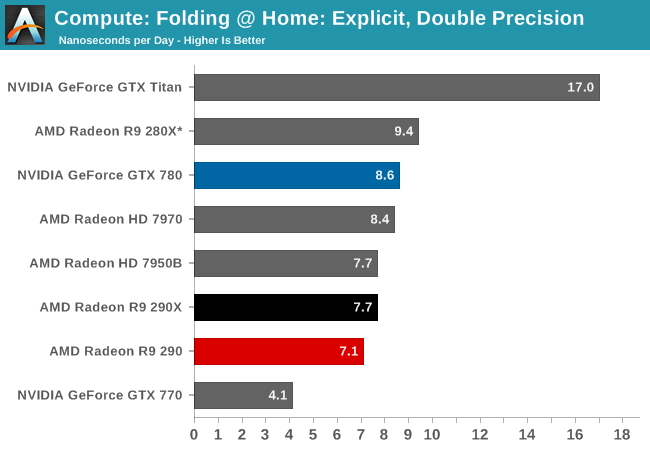
Generally Tahiti and Hawaii are strong performers in the GPU compute arena, but that isn’t of particular help to the 290 here, as it loses out to the GTX 780 in every mode. In single precision FAHBench has trouble putting Hawaii to good use at times, while double precision tests have the 1/8th DP rate 290 and 290X falling behind due to their lower than Tahiti DP throughput.
Wrapping things up, our final compute benchmark is an in-house project developed by our very own Dr. Ian Cutress. SystemCompute is our first C++ AMP benchmark, utilizing Microsoft’s simple C++ extensions to allow the easy use of GPU computing in C++ programs. SystemCompute in turn is a collection of benchmarks for several different fundamental compute algorithms, as described in this previous article, with the final score represented in points. DirectCompute is the compute backend for C++ AMP on Windows, so this forms our other DirectCompute test.
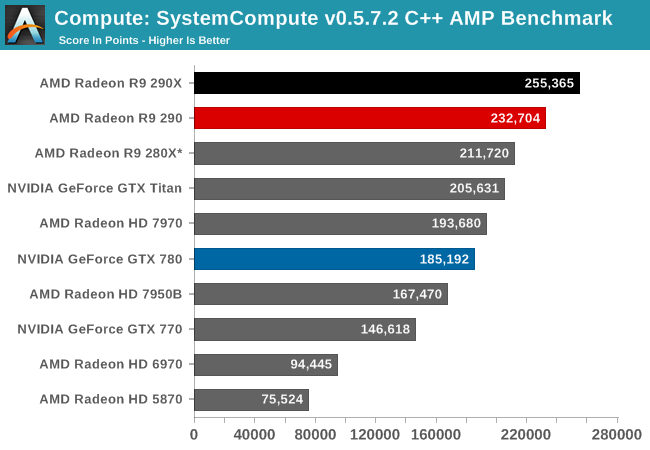
SystemCompute is another benchmark where 290 and 290X do not experience meaningful throttling, and as such are separated by more than what happens in our gaming benchmarks. In this case 290 yet again trails 290X by 9%, though it still enjoys a considerable lead over the GTX 780 and all other NVIDIA cards.










295 Comments
View All Comments
swing848 - Tuesday, November 5, 2013 - link
It will only get loud for me when playing games or the occasional benchmark. During games I weara headset, and during benchmarks I can leave the room. I have a room dedicated to computer use
and the house has good sound proofing, so, it will not bother other people.
If I want it quiet I will use a water cooler with a large radiator and fan, my Cooler Master HAF
922 case already has sealed holes for tubing for an external radiator.
Water cooling is better than dumping all the hot air from the video card into my case, even if it
is well cooled with 200mm fans. I overclock my CPU and I do not want it, RAM, or chips on the
motherboard to get any hotter than necessary.
The only thing I will miss on this card are Black Diamond Chokes and Digital Power 8+2+2 phase
used on the Sapphire R9 280X Toxic [Black Diamond Chokes are also used on Sapphire R9 280 Vapor-
X]. To be honest I do not know how many mosfits are dedicated to cool GPU functions on the R9
290. In any event, both the Toxic and Vapor-X dump hot air into the case.
Another thing I would like to have seen on the Sapphire R9 290 is a metal back plate.
somethingwicked - Tuesday, November 5, 2013 - link
what the holy gee whizthe new AMD drivers are insane! 290x is speeding past Titan now and 780 is a turtle while 290x is a ferrari... the new 290 is performing like the 290x was at launch and now the 290x is a card unto its self at the top of the food chain
thank goodness for competition
i smell more deep nvidia price cuts cause AMD is kicking butt
TheJian - Tuesday, November 5, 2013 - link
rofl. So NV just has to release a "fan that drives you out of the room" driver now to respond. IF NV did this all of you would be falling all over yourselves to moan and groan claiming NV was cheating. AMD does it, and wow this is awesome, I love the noise anyway...LOL. Technically this is all NV has to do though right? Raise the fan speed until it hits another 10DB's and blow them down again.Perf is great, but not if it drives me out of my room. There is nothing stopping NV from adding 10DB's to their cards and calling it a day. But I don't want this being called normal. IMHO this is a crap way to get perf and a game both sides can play. If NV does this tomorrow and says we're hiking prices because if we overclock our cards also (which is essentially what they're doing here, just reverse, raise fan so clocks boost higher, same story) we blow AMD away.
https://www.youtube.com/watch?v=djvZaHHU4I8
Both cards clocked to max (290x vx. 780, NOT TI mind you).
Fast forward to 8:40 for benchmarks...AMD is blown away. The 780 didn't lose ANY game. Not one. And in star citizen blows AMD away. I don't believe these cards will be used mostly on 1600P or 1440p either. 1080/1200p is running on 98.5% of our screens and a large portion of the 1.5% that is above these two resolutions are running TWO or more cards. Steam's surveys don't lie. Already they turn down nearly every game at 1440p here which to me means you won't run there anyway (they are not reporting mins here for most games). Everything is pretty maxed in linustechtips vid above at 1080p, and you should be able to stay above 30fps (probably?) doing it. They are reporting avg's here at anandtech and already turning stuff down. Meaning maxing graphics on a lot of games would be unplayable under 30fps especially when lots of crap is going on. LOW DETAIL? Seriously? So Ryan is assuming you'll buy one of these cards (or any single gpu card) to then go out and buy a 1440p monitor (which are still over $550 for any brand you'd recognize the name of on newegg, and start there when you choose NEWEGG ONLY) and then run the details on low to play games? I don't think so. If he's assuming we're all going to buy new monitors, might as well get Gsync instead (though I'd say wait for more models first even if Asus has a decent one out of the gate). Heck some of the games have details DOWN on 1080p here (total war2, medium shadows? still looks like it would hit below 30fps on most cards).
For anyone saying get a water block...LOL. How much did my card cost if I have to add that and how many regular users even know what water is or are even capable of adding one? I say that as a guy who has as Koolance kit. Or even adding an aftermarket fan. Isn't this upping the cost of the card then?
Both solutions are unacceptable and attempting to fix a problem caused by shipping a card that already is unacceptably NOISY, hot and sucking up watts vs. it's competition. No games either.
Add on top reviews elsewhere show other games that give an opposite story. Techpowerup, Techspot, Guru3d, Hardocp show wins for AC3, COD Blackops2, Diablo3 (spanked by NV), FarCry3, SplinterCell Blacklist, Star Craft2 (spanked, heck 770 does well), World of Warcraft (spanked), Skyrim (lost 3 resolutions, 290/x won 1600p, oddly lost upping to 5760), Resident Evil 6.
So maybe you need to take a bit of a WIDER view than anandtech ;) I don't call 53 more watts than 780 (or 70 more than 770) a victory. Never mind the noise it creates while doing it. Is running 10DB's higher really a better card? Do people here realize that noise in DB's is EXPONENTIAL? A 10Db noise difference is HUGE (ryan did say 2x as loud). 12 degress hotter for this kind of perf isn't good either. I see a clear reason NV should be charging more than AMD's cards. They are better. I can OC and beat them easily without all the noise, heat, watts. I don't need a waterblock to do this either...ROFL. Whatever I already have on my card can do this easily and come in UNDER Ryan's 7970 noise levels that he calls acceptable.
I see no price cuts, but probably a few more videos poking fun at AMD like this:
https://www.youtube.com/watch?v=oV5vs27wnCA
Tell me that isn't funny ;) I'm wondering if someone at NV paid for this vid to be made...LOL. Sparks, dripping fire, ROFL. Great job of getting the message across.
rviswas11 - Tuesday, November 5, 2013 - link
i couldn't give two s***ts because when i game i wear noise cancelling headphones that i use for listening to music on the busrviswas11 - Tuesday, November 5, 2013 - link
so i'm happy. and with the exception of skyrim i could set the graphics card to 10% fan profile and max the game. i run quite afew mods for skyrim don't play it anymore.but i can see how the noise can be a major issue for a lot of people.
Morawka - Tuesday, November 5, 2013 - link
your not understanding. At this level of noise, not even noise canceling headphones will drown it out. This is louder than a 747 jet from 100 meters away.mgl888 - Tuesday, November 5, 2013 - link
You'd better be trolling.60dB is the intensity of a normal conversation.
Galidou - Tuesday, November 5, 2013 - link
Comon, a 747 jet 100 meters away... you gotta be freaking stupid to only think it could be true :Oahlan - Saturday, November 9, 2013 - link
@GalidouWhat do expect from nvidia fantards who think higher price is better.
They are so unsecure and delusional that they comment in every AMD review...
Nvidia is loving their stupidness...
1Angelreloaded - Saturday, November 16, 2013 - link
120 decibels is a 747 I would know I work around them, But AMDs new cards are crap, 550$ to add a water cooling system totaling around 200-300$.......either way its not a deal really, Nvidia cards have more headroom on air and water, while AMD's cards are impressive to an extent Hawaii is a bastard step child of sorts, it is probably a failed version of the next chip to compete with Maxwell but had no choice but to release it.